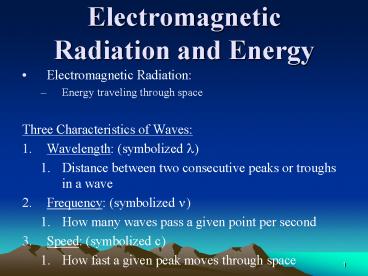Electromagnetic Radiation and Energy - PowerPoint PPT Presentation
1 / 22
Title:
Electromagnetic Radiation and Energy
Description:
Bohr's Model. Explains emission spectrum of H ... Can also use orbital box or line diagrams. Let's take a look. 15. Pauli Exclusion Principle ... – PowerPoint PPT presentation
Number of Views:79
Avg rating:3.0/5.0
Title: Electromagnetic Radiation and Energy
1
Electromagnetic Radiation and Energy
- Electromagnetic Radiation
- Energy traveling through space
- Three Characteristics of Waves
- Wavelength (symbolized l)
- Distance between two consecutive peaks or troughs
in a wave - Frequency (symbolized n)
- How many waves pass a given point per second
- Speed (symbolized c)
- How fast a given peak moves through space
2
(No Transcript)
3
Electromagnetic Radiation and Energy
- c ? x ?
- c speed of light 2.9979 x 108 m/s
- ? frequency (s-1 or Hz)
- ? wavelength (m)
4
(No Transcript)
5
Spectra
- Sunlight yields continuous spectrum
- Energized gaseous elements yield certain
wavelengths - Line emission spectrum
6
Rydberg
- Why did gaseous atoms emit certain wavelengths?
- Didnt find out why, but came up with an equation
- Rydberg equation
- N3, red line
- N4, green line
- N5, blue line
- Lyman series
- n 1 to n 1
- UV (invisible)
- Balmer series
- n 2 to n 2
- Visible wavelengths
7
The Bohr Model of the Atom
- Explained Rydberg
- Electron energy quantized
- Electron only occupies certain energy levels or
orbitals - If it didnt, electron would crash into protons
in nucleus - As n increases energy becomes less negative
- Increases
- Only certain amts of E may be absorbed/emitted
- If electron in lowest possible energy level
- Ground state
- If electron in excited energy level
- Excited state
- One can calculate energy needed to raise H
electron per atom from ground state (n1) to
first excited state (n2)
8
Bohrs Model
- Explains emission spectrum of H
- Movement of electrons from one quantized energy
level to a lower one gave distinct emission
wavelengths - Model only good for one electron system
9
Atomic orbital
- The probability function that defines the
distribution of electron density in space around
the atomic nucleus.
10
The s-orbital
- The simplest orbital
- The only orbital in the s-subshell
- Occurs in every principal energy level
- s stands for sharp
- The first energy level only houses this orbital
- Can house up to 2 electrons
11
The p-orbitals
- Start in second principle energy level (n2)
- There are three p-orbitals in the p-subshell (see
below) - And one s-orbital
- p stands for principle
- Can house up to 6 electrons
- Has one nodal surface
- Nodal plane a planar surface in which theres
zero probability of find an electron - 2px 2py 2pz
12
The d-orbitals
- Start in third principle energy level (n3)
- There are five d-orbitals in the d-subshell
- And one s-orbital
- And three p-orbitals
- Can house up to 10 electrons
- d stands for diffuse
- Has two nodal surfaces
- 3dyz 3dxz
3dxy 3dx2-y2
3dz2
13
The f-orbitals
- Start in fourth principle energy level (n4)
- There are seven f-orbitals in the f-subshell
- And one s-orbital
- And three p-orbitals
- And five d-orbitals
- Can house up to 14 electrons
- f stands for fundamental
- Has 3 nodal surfaces
14
Electron configuration
- Electron must be identified as to where it is
located - Hydrogen
- One electron in first energy level and s-subshell
- Thus, 1s1 ( Aufbau electron configuration)
- 1 states energy level (n)
- s designates subshell
- Superscript 1 tells how many electrons are in the
s-subshell - Can also use orbital box or line diagrams
- Lets take a look
15
Pauli Exclusion Principle
- An atomic orbital holds a maximum of two
electrons - Both electrons must have opposite spins
- ms 1/2 -1/2
16
Hunds Rule
- Electron configuration most stable with electrons
in half-filled orbitals before coupling
17
Subshell filling order not what one expected
18
Using the Periodic Table to advantage
19
Short-hand vs. long-hand Aufbau electron
configuration
- F
- Al
- Ca
- Br
20
Exercises
- Give me the Aufbau electron configurations for
- Y
- Te
- Hf
- Tl
- 112
21
Sundry matters pertaining to d-block metals
- Stability is increased when
- d-subshell is half-filled (d5)
- d-subshell is completely filled (d10)
- Electrons will be taken from the s-subshell to
fill the d-subshell - But there is a limit
- No more than 2 electrons taken from s-subshell
- Given the above, which subshell electrons will
d-block metals lose first when they ionize? - So what are the correct electron configurations
of Cr and Ag? - Caveat
- Not all metals follow the above i.e., take from
s-subshell and give to d-subshell - Ni Pt, for example
22
Sundry matters pertaining to f-block metals
- Stability is increased when
- f-subshell is half-filled (f7)
- f-subshell is completely filled (f14)
- Electron will be taken from the d-subshell to
fill the f-subshell - Eu Yb
- Am No































